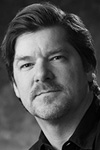

|
| Peter Krogh |

Since its inception, photography has been one of the most technical of art forms. To answer the question “How will photographic technologies develop in the future?” we turned to USA-based photographer, author, lecturer and consultant Peter Krogh.
Says Peter: “From the wet plate through the development of automatic film cameras, photographic technologies have driven the practice of the profession, as well as aesthetic sensibilities.
It’s certain that new imaging technologies will alter how photography is created, distributed and understood, at least as much as the introduction of color film changed it in the past.
One of the most obvious changes in photojournalism is the ease of electronic image distribution. This trend is certain to continue. It is easier for news organizations to find photographers in the field, accept submissions and distribute worldwide.
The dissemination of images is so quick, it would have seemed like science fiction a few short years ago.
We also likely to see a large increase in photo sharing sites like Flickr and image databases like Google.
These services will increasingly be able to know what pictures are about and which are the best through ‘crowdsourcing data’. (The more users select an image after a search, the more the service thinks that’s a “good” picture of the searched item.)
Posting and publishing images from the field is being simplified with tools like the Eye-Fi media card, which acts as both memory card and a wireless connection, searching out nearby Wi-Fi networks and automatically uploading images. The card can even access a database of Wi-Fi access points to tag the images with the location information. While its current form may not work yet for photojournalists, this technology is an area of rapid growth.
There is a trend in the industry to tag images automatically. In addition to the timestamp that your camera puts on the card, GPS location information promises to bring a revolution in automatic metadata creation for images.
Once where and when an image was created is established, you know quite a bit about the picture without the photographer having to input any keywords. Scheduled events like a World Cup football match can easily be tagged by time and place. And even unscheduled events like a protest or other conflict will still reside within the boundaries of a particular space and time (it happened at this place, starting at this time and ending at this time).
Flickr has beta programs now that can spread one person’s photo annotation far and wide. It won’t be too long before it will be available to anyone with an internet connection. The concept at work is ‘data exhaust’ - as in something coming out of the tailpipe.
Data aggregation like this promises to revolutionize news gathering. All the electronic devices in a particular place collectively describe information about what is happening in that place - who is there, who was called, what was scheduled for what time. In fact, it will ultimately be possible to stitch together the photographic record in ways that develop a four-dimensional record of history (3 dimensions, plus time).
We’re also rapidly seeing the convergence of still and motion imaging technologies (see Cool Kit in this edition). Still cameras are now capturing good motion images and video cameras are now capable of producing publication-quality images.
As distribution vehicles for news-gathering increasingly become electronic, the distribution is converging as well. The lines between broadcast, print and web have effectively been erased. In the software world, Photoshop is becoming more adept at creating and dealing with motion graphics.
And perhaps as revolutionary as anything else will be the change in the aesthetics of photography. By combining a number of images taken with different exposures - High Dynamic Range (HDR) imaging - the photographer can re-interpret tonal values in a photograph more like the brain does, as opposed to the eye. At first look, HDR seems “un-photographic”, but increasingly, it will become the norm in photographic imaging.
In fact, the way we have come to define a “straight” photo is really based on whether the image represents the light and tone the way film does. It is important to understand that there’s nothing objectively truthful about the way film creates an image. It is a chemical process determined by the limits of the medium, the film’s manufacturer and choices made by the photographer, lab and printer.
Similar to changes in music, the evolution in photography is being driven by new technologies, new sensibilities and new distribution models.
As photojournalists confront a rapidly changing medium, they will need to figure out how to use the new tools to tell stories that are relevant and speak to the hearts of the viewers, in a language that they understand.
The institutions of journalism need to address these issues - to stand fast
to the principles that underlie integrity and to know how to use these wonderful
new tools to promote the important job of truthful storytelling."
|